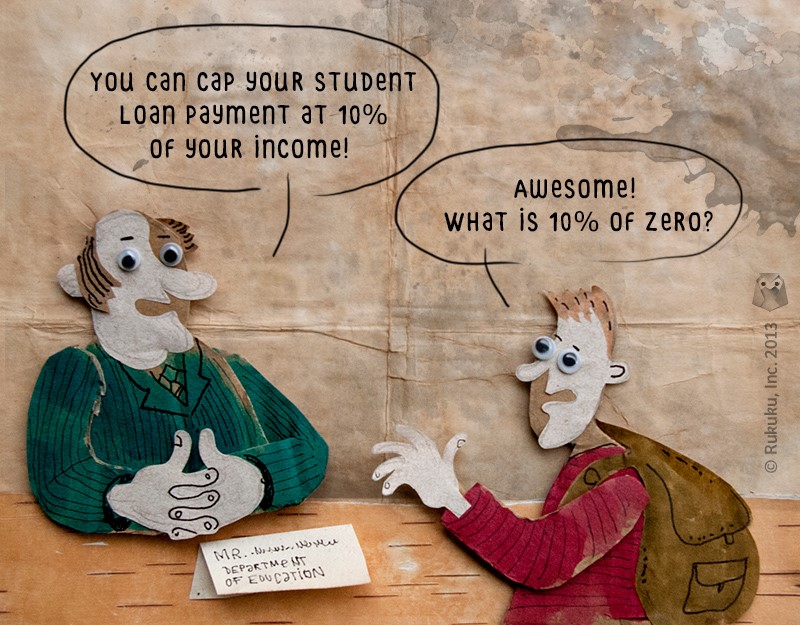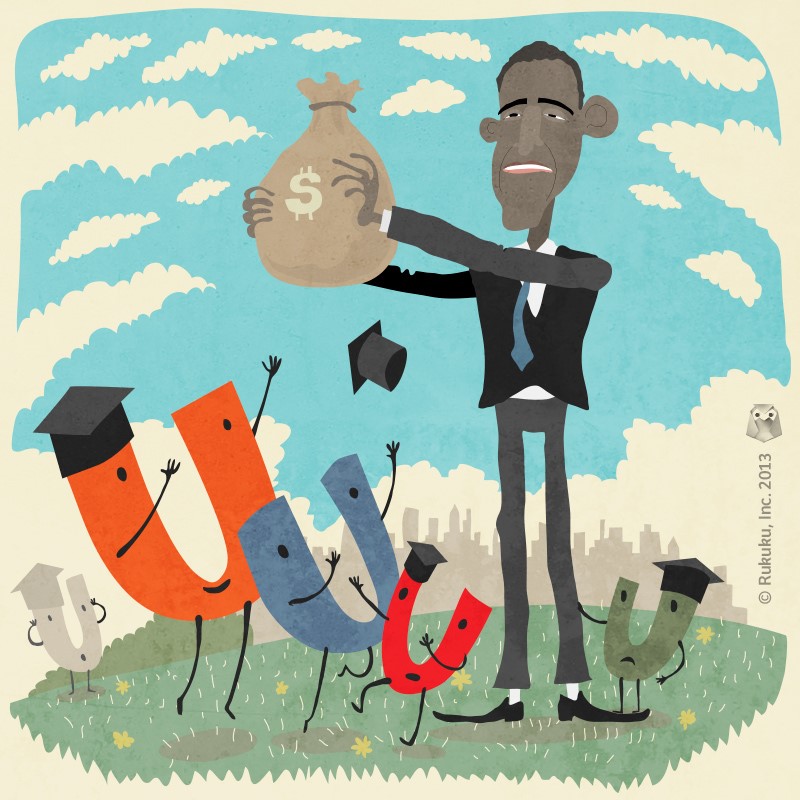Rank and File: Education Reform and College Ranking
In our most recent posts, we looked at Obama’s proposed higher education reform and its provisions for limiting student loan payments and in some cases forgiving debts. Those policies are relatively straight forward, despite a few challenges we highlighted.
The most central and more complicated part of Obama’s education plan relates to its college ranking system. For this, the Department of Education will rank universities and colleges based on several factors including graduation rate, loan default rate, average debt loads, and graduate employment rates.
Eventually, these rankings will influence the awarding of federal money for student tuition. In other words, schools that offer better deals for students will get more investment from the federal government.
It sounds reasonable enough for an investor to evaluate the potential returns. In this case, that investor is the federal government, on the one hand, and the incoming student, on the other. In both cases, knowing more about these rates should be important. This reform will make that information widely available, something that is not the case currently, as we’ve discussed in previous posts.
The more challenging part of the ranking process will be determining the proper weight of each element of the criteria without making them vulnerable to manipulation or disadvantaging schools that may be doing good things that are tougher to quantify. For example, low income students, even those with high test scores, are less likely to complete college.
Check out this graphic below, taken from this excellent 2012 blog post by Elise Gould, of the Economic Policy Institute: http://www.epi.org/blog/college-graduation-scores-income-levels/
Colleges then will have to weigh the advantages given in the ranking to assisting low-income students against the disadvantages of a possible decrease in the graduation rate. That could discourage universities from recruiting lower income students or really any students with higher risks of dropping out.
This doesn’t have to be the case, but the Department of Education must be careful when it evaluates and assigns values to the various pieces of the magical equation that will determine rankings.
That being said, the most influential aspect of this plan, at least early on, will likely be its emphasis on transparency. It is important to have this information easily available and just as important that colleges are aware that it is easily available. That will give them incentive to improve in these categories.
Taking the next step, though, and using that information to come up with a specific rank for each school could result in some unintended consequences, especially when tied directly to funding. Schools will have strong incentives to massage their numbers, and the Department of Education must be very careful to minimize the possibilities for them to do so.
To Borrow is Human; to Forgive, Divine.
In our last post, we talked about Obama’s plan to cap student loan payments at 10% of monthly income. Today we’re looking at another part of program, the loan forgiveness clause. When student debt payments drag on until the 20 year mark, the government automatically erases the debt. For those working in the public sector, the government takes over the debt after 10 years.

Uncle Sam forgives the remaining student loan debt after ten years for those working in the public sector.
The challenge with such a program is, as with anything anywhere, preventing people from taking advantage of the rules. Politico brought one such case to light recently, related to the 10 year forgiveness plan for public sector employees. Law schools at Georgetown and other universities advertised programs requiring no student loan payments ever, partly because of government programs.
In a sense, it is a generous program. Georgetown offers to make ten years of loan payments for law graduates that work in the public sector. But then, the government takes care of the rest, and this is even advertised on the program website. Check it out here. https://www.law.georgetown.edu/admissions-financial-aid/office-of-financial-aid/lrap/LRAP-III.cfm
With income-based payments, borrowers obviously make less progress on the underlying principal, meaning a larger amount is still outstanding after ten years. For professional school graduates, that amount can easily reach beyond $100,000.
For reference, here’s the politico story: http://www.politico.com/story/2013/08/law-schools-devise-debt-free-path-to-degree-95391.html
It is not quite as scandalous as an iPhone pic of a private part, but it is hard to believe this is what lawmakers were hoping for when they passed the original law in 2007 or when Obama shortened the time limits and lowered the income caps last year. (nor what Apple was hoping for when it created the iPhone).
When the government caps the payments at 10% of income, one would assume it is the borrower making those 10% payments, not their former university or anyone else. Does that count as extra income, for example? If so, do they have to recalculate the 10%? This is only one case, of course, and not an egregious one, but my guess is there will be more, especially as the program expands.
All that being said, an average participant in the program does get a lighter load in leaner times and still has responsibility for the loan. That’s what the program should do. Graduates don’t get out of the debt by making lower payments. They just extend the amount of time they will be paying on the loan, which of course means more interest payments long term. But they get a break, when they need it.
While the government will forgive the loan after 20 years (10 years in the public sector, as I mentioned above), 20 years of paying 10% of your income and still being in debt does not seem like getting off that easily. People are creative, though. Going forward, we’ll see how many more stories come up involving imaginative ideas for offloading loans at that ten or even twenty year mark. Feel free to share any such ideas in the comments section.
In our next post, we’ll look at the cost control aspects of Obama’s plan.
Pay-As-You-Earn Pays Off for Young Grads
In recent posts, we’ve discussed student debt, rising tuition, competency-based credit, technology in education, and accountability for graduation rates and debt load, among other topics. Well, it turns out that Obama has been reading some of the same blogs we have. His education plan, introduced last week, includes several proposals relating to these very issues. Let’s take a look at them, starting today with student debt.
The plan calls for an expansion of the Pay-As-You-Earn plan, which caps monthly student debt payments at 10% of income, with loans forgiven after 20 years, or 10 years for those working in the public sector. The original law setting the precedent for this was passed back in 2007, with the caps lowered to 10% and time until forgiveness shortened last year from 25 to 20 years.

Obama’s Pay-As-You-Earn program allows recent graduates to limit their monthly student loan payments to 10% of monthly income
At the moment, only students that took out their first loans after 2008 and their most recent loans after 2011 are eligible for the Pay-As-You-Earn program. Obama wants to expand the program to include all federal student loan borrowers. So far, only 2.5 million of 37 million federal borrowers are enrolled in income-based repayment programs, including the previous versions. Part of the reason is eligibility. Another part is awareness.
Many borrowers don’t know that they qualify for lower payments. For that reason, as another part of Obama’s plan, the government will spend money to teach graduates to save money through these programs. Maybe the government can advertise them on twelve packs of cheap beer.
I don’t mean to imply that all indebted, recent college grads are sitting around drinking cheap beer. I mean to imply that I sat around drinking cheap beer when I was recently graduated and in debt. I am sure some recent grads are still doing that.
I am also sure some recent grads are struggling to move beyond part-time jobs at restaurants and retail stores and into career-building work. Some less recent grads are, too. Those transitions into better paying jobs take time, especially in a weak job market, and a 10% cap on loan payments will help during that process.
The awareness campaign will focus on educating guidance counselors and tax specialists, as well as graduates with debt. They may need it. I had a hard time understanding some details, especially in relation to earlier versions of the plan. This proposal may do away with those earlier versions. Or maybe it won’t. See, I’m not clear on this.
To better explain such details, the Department of Education will set up “one-stop shops” with resources on the income-based payment plans. The challenge will be to keep those shops up-to-date and motivated to get the message out. It would be easy to set up a booth on campus and sit around drinking smoothies all day. I don’t mean to imply that all Education Dept. employees like smoothies. I mean to imply that I like smoothies.
In our next post, we’ll look at loan forgiveness and some mild moral hazard.
Factors to consider with online study
Education in Debt: Part Three
With costs soaring and debts deepening, many students, universities, and lovers of learning are turning to online and blended programs that reduce or eliminate physical class time. Georgia Tech, for example, recently rolled out an online computer science master’s program incorporating large scale lectures, smaller online discussions, and individual assignments. The program costs less than half of the price of its on-campus master’s degree. Until college fees come down, or even if they do, we will probably see more and more of these hybrid programs. In fact, Rukuku hopes that we can host many of them here.
Beyond the move to online learning environments, greater accountability will help. Writing on behalf of the non-profit think tank Educational Sector, Andrew Gillen recommends that the Department of Education provide information pairing graduation rates and student loan default rates at colleges and universities. In this way, students can make better informed decisions. And for their part, students need to pay more attention to graduation rates and average debt loads for graduates at perspective universities. Some of President Obama’s recent proposals on higher education relate to this accountability issue, and we will discuss those in our next post.
Overall, more universities should realize that the music may soon stop on this higher education game, and less expensive-online competitors are quickly filling the seats behind them. The US is known worldwide for the quality of education provided at its universities. The costs are also well-known and sadly becoming the more prominent feature. With the internet greatly expanding the avenues for education, some universities may find they’ve priced themselves out of the market.





